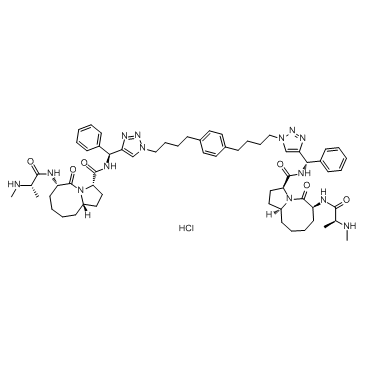SM-164 Hydrochloride |
| Catalog No.GC37649 |
El clorhidrato SM-164 es un compuesto mimético Smac permeable a las células. SM-164 se une a la proteÍna XIAP que contiene los dominios BIR2 y BIR3 con un valor IC50 de 1,39 nM y funciona como un antagonista extremadamente potente de XIAP.
Products are for research use only. Not for human use. We do not sell to patients.

Sample solution is provided at 25 µL, 10mM.
SM-164 Hydrochloride is a cell-permeable Smac mimetic compound. SM-164 binds to XIAP protein containing both the BIR2 and BIR3 domains with an IC50 value of 1.39 nM and functions as an extremely potent antagonist of XIAP. XIAP|1.39 nM (IC50)|cIAP-1|0.31 nM (Ki)|XIAP|0.56 nM (Ki)|cIAP-2|1.1 nM (Ki)|cIAP
SM-164 is a non-peptide, cell-permeable, bivalent small-molecule, which mimics Smac protein for targeting XIAP. SM-164 binds to XIAP containing both BIR domains with an IC50 value of 1.39 nM, being 300 and 7000-times more potent than its monovalent counterparts and the natural Smac AVPI peptide, respectively. SM-164 concurrently interacts with both BIR domains in XIAP and functions as an ultra-potent antagonist of XIAP in both cell-free functional and cell-based assays. SM-164 targets cellular XIAP and effectively induces apoptosis at concentrations as low as 1 nM in leukemia cancer cells, while having a minimal toxicity to normal human primary cells at 10,000 nM[1]. The binding affinities of SM-164 to XIAP, cIAP-1, and cIAP-2 proteins are determined using fluorescence-polarization based assays. SM-164 has a Ki value of 0.56 nM to XIAP protein containing both BIR2 and BIR3 domains. SM-164 has a Ki value of 0.31 nM to cIAP-1 protein containing both BIR2 and BIR3 domains. SM-164 binds to cIAP-2 BIR3 protein with Ki values of 1.1 nM. Addition of exogenous TNFα can significantly enhance the activity of these Smac mimetics, especially for SM-164, in resistant cancer cell lines such as HCT116 and MDA-MB-453[2].
SM-164 is evaluated for its ability to inhibit tumor growth. SM-164 is highly effective in inhibition of tumor growth and capable of achieving tumor regression in the MDA-MB-231 xenograft model. Treatment with SM-164 at 1 mg/kg completely inhibits tumor growth during the treatment. Treatment with SM-164 at 5 mg/kg reduces the tumor volume from 147±54 mm3 at the beginning of the treatment (day 25) to 54±32 mm3 at the end of the treatment (day 36), a reduction of 65%. The strong antitumor activity by SM-164 is long lasting and not transient. SM-164 at 5 mg/kg is statistically more effective than Taxotere at the end of the treatment (P<0.01) or when the tumor size in the control group reaches 750 mm3 (P<0.02)[2].
[1]. Sun H, et al. Design, synthesis, and characterization of a potent, nonpeptide, cell-permeable, bivalent Smac mimetic that concurrently targets both the BIR2 and BIR3 domains in XIAP. J Am Chem Soc. 2007 Dec 12;129(49):15279-94. [2]. Lu J, et al. SM-164: a novel, bivalent Smac mimetic that induces apoptosis and tumor regression by concurrent removal of the blockade of cIAP-1/2 and XIAP. Cancer Res. 2008 Nov 15;68(22):9384-93.
Average Rating: 5 (Based on Reviews and 27 reference(s) in Google Scholar.)
GLPBIO products are for RESEARCH USE ONLY. Please make sure your review or question is research based.
Required fields are marked with *




















